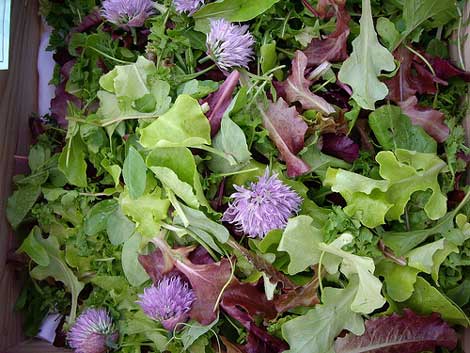
“Have nothing in your house that you do not know to be useful or believe to be beautiful” – William Morris.
You don’t have to be a farmer to grow your own food, just a little patch in your back garden should enable you to grow a fair bit of your own produce. But some people just aren’t keen on the idea of giving over their lawns and ornamental gardens to the planting of food plants for fear that they’ll lose the attractiveness of the gardens that they delight in. It doesn’t have to be like that. There are lots of beautiful plants and flowers that are edible, or extremely useful in the growing of an organic food garden.
Removing food miles from your dinner plate is such a great way to go green and really cut back your carbon footprint considerably. So how about having a go this coming summer at growing something that you can proudly put on a plate and feed to family and friends, knowing that you’ve grown it yourself.
There are four ways that you could incorporate some beautiful food into your garden.
1. Permanent beds of perennial or self-seeding plants
Having permanent beds in your garden provides stability for wildlife over the winter, but also means less work for you once they’ve been planted. There are a few herbs that suit this job perfectly: rosemary, echinacea, bergamot, lemon balm, evening primrose, mint and oregano. Nasturtiums are also great, but you will need to keep them in check. This sort of bed looks great in between vegetable beds that lie empty in Spring.
2. Annual beds
Include an edible flower bed in your rotation with vegetables to have extras for salads, plants that attract pests away from your vegetables and some pretty flowers for the table. Calendula (marigolds) and nasturtiums are my favourite flowers for this purpose. You could also try pansies.
3. Feral flowers
If you’re brave enough to, set your flowers free to self-seed and grow randomly. Self-seeders like evening primrose, common mallow, nasturtiums and calendula can decide for themselves where to enjoy their next life-cycle. But you’ll have to take them in hand if they spread too far for your liking.
4. Vegetable flowers
The benefits of allowing some of your vegetable plants to go to flower is their bug attracting power, the fact that you’ll be able to save seed from the plant for your next vegetable crop, and that you can enjoy the blooms in your salads too. Leave some of your chives, rocket and radishes to flower for just those reasons. Other plants give you both the flowers and the vegetable, like baby marrows.
For more edible flower ideas, have a look here.
Photo credit: startcooking kathy & amandine
[ad#468×60]